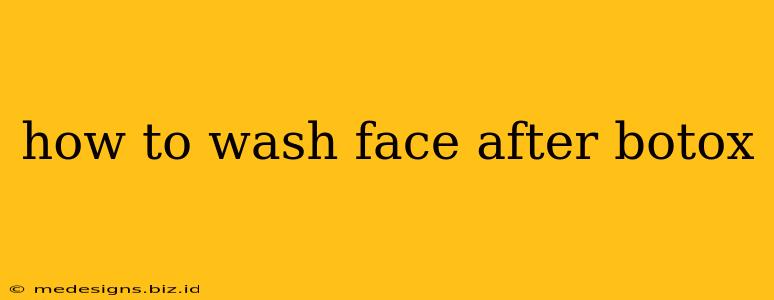Botox is a popular cosmetic treatment that can help reduce the appearance of wrinkles and fine lines. While the procedure itself is relatively quick and painless, proper aftercare is crucial for optimal results and minimizing the risk of complications. One of the most frequently asked questions is: how to wash your face after Botox? This guide provides a detailed, step-by-step approach to facial cleansing post-Botox.
Gentle Cleansing: The Key to Post-Botox Care
The key to successful post-Botox facial cleansing is gentleness. Avoid harsh scrubbing, vigorous rubbing, or any actions that could potentially disrupt the injected areas. Remember, your skin is still healing and needs extra care.
What to Do:
- Wait at least 4-6 hours: Before washing your face after Botox, allow at least four to six hours for the injections to settle. This waiting period helps prevent the spread of Botox to unintended areas.
- Use lukewarm water: Avoid hot water, as it can increase inflammation and potentially cause discomfort. Lukewarm water is gentle and effective for removing dirt and impurities.
- Choose a gentle cleanser: Opt for a fragrance-free, hypoallergenic cleanser specifically designed for sensitive skin. Harsh chemicals and fragrances can irritate the treated areas and hinder the healing process. Look for cleansers that are non-comedogenic (won't clog pores) and sulfate-free. Many drugstores and skincare brands offer suitable options.
- Pat dry, don't rub: After cleansing, gently pat your face dry with a clean, soft towel. Avoid rubbing, which could irritate the skin and potentially displace the Botox.
- Avoid harsh exfoliants and scrubs: For at least a week after your Botox treatment, avoid using harsh exfoliants, scrubs, or any products that may cause irritation. These can interfere with the healing process and even lead to bruising or swelling.
- Be mindful of makeup application: If you choose to wear makeup, apply it gently and avoid rubbing or tugging on the skin. Use a gentle makeup remover to remove it in the evening.
What to Avoid:
- Hot water: As mentioned before, hot water can dilate blood vessels and cause inflammation.
- Harsh cleansers: Avoid cleansers containing alcohol, fragrances, or harsh chemicals, which can irritate the skin.
- Vigorous scrubbing: Treat your skin gently to prevent irritation and the potential displacement of Botox.
- Excessive touching: Avoid touching the treated areas unnecessarily to prevent the spread of bacteria and potential infection.
- Intense exercise: For the first 24 hours, refrain from strenuous activity or intense exercise, as increased blood flow can increase swelling.
Maintaining Your Skincare Routine
While you need to adjust your skincare routine after Botox, you don't have to completely overhaul it. Consistency is key to healthy skin. Continue to follow your usual skincare routine, focusing on gentle products and avoiding harsh treatments for at least a week after the procedure.
When to Seek Medical Advice
While facial cleansing after Botox is usually straightforward, it's important to know when to contact your doctor. Contact your physician immediately if you experience:
- Excessive bruising or swelling: While some minor bruising and swelling are normal, excessive or persistent swelling should be addressed.
- Severe pain or discomfort: Persistent or intense pain in the treated area requires immediate medical attention.
- Signs of infection: Redness, pus, or increased pain could indicate an infection.
By following these simple guidelines on how to wash your face after Botox, you can help ensure your treatment results are optimal and minimize any potential complications. Remember, gentleness is key! Always consult your doctor or dermatologist for specific post-treatment care instructions tailored to your individual needs and skin type.
